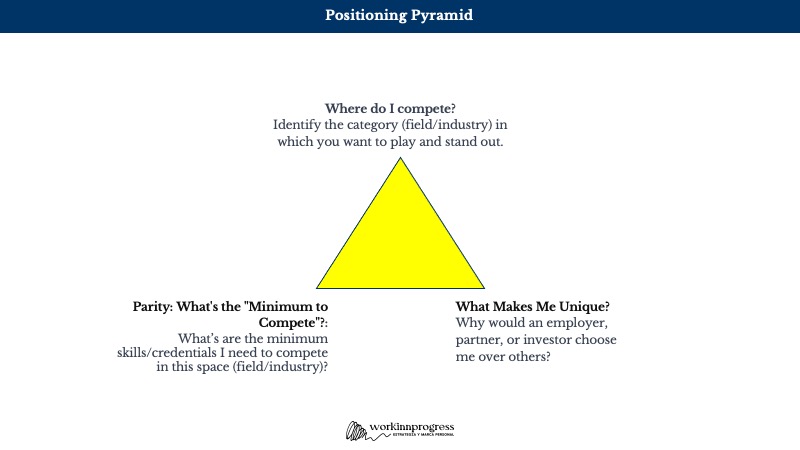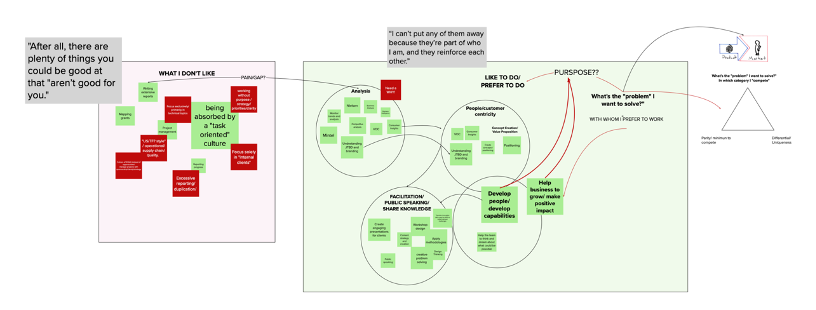Edition #6
Crafting your Personal Brand Positioning: Where Do you want to be positioned in people's minds?
One of the most critical tasks when introducing a new product or brand to the market is clearly defining its desired position in the minds of potential consumers. By effectively positioning the product or brand in the minds of consumers, companies can increase brand awareness, drive sales, and establish long-term customer loyalty.
This complex task requires finding the balance between being easily recognizable and generating interest/novelty. It is also essential to reflect the desired values and clearly express what makes that product or brand unique and different. This is what is referred to as defining positioning.
The same applies to people. Those who know you have a perception of who you are, just like they do with brands and products.
We are not the same for everyone, nor are we equally essential or relevant to everyone. However, each of our actions leaves a mark on those who interact with us.
Branding and innovation teams work hard to establish the positioning of their products and brands. Similarly, you must take charge of the positioning you hold within your spheres of interest. What place do you lodge in the minds of your boss, colleagues, clients, investors, students, or even family and friends? Your positioning is an integral part of your personal brand.
The Positioning Pyramid is a simple tool I have used when designing products and brands. Today, I'm sharing how you can apply it to your professional life.
THE THREE VERTICES OF THE PYRAMID

1. Where Do I Compete?
This pyramid vertex refers to the category in which you want to compete or play a role. In traditional product and service design, defining a category to compete in, such as beverages, baby food, gyms, banking, or floor cleaners, is advisable. Adhering to certain classifications allows brands and products to understand their market share. With a classification, comparison is possible.
As an individual, the equivalent classification could be your profession, such as lawyer, engineer, teacher, or actor.
In recent years, the lines defining categories have blurred for both products and individuals, and we increasingly see niche products and super specializations.
In what category do you compete?
Nowadays, job descriptions and roles are becoming more fluid. Merely mentioning that you are an "architect" or innovation specialist" isn't enough to convey your job description or role.
If you look at LinkedIn, you'll notice that job descriptions and roles have changed significantly.
Here is my recommendation: carve out a recognizable category by adding what makes you unique (we'll see this in the following vertices of the pyramid) or define your category in terms of the 'Job To Be Done' you fulfill. For example, a category could be coaching, but it can also be expressed as "helping people improve their relationships." That opens opportunities for you, as you could find different ways than coaching to help people.
If you feel inclined to create a new category, such as "dream collector," "illusion materializer," "prompt engineer for ChatGPT," or something similar, keep in mind that you'll need to invest in educating your target audience. I had to do it when I adopted my positioning as an innovation catalyst; ten years ago, nobody used it, but now it's much more common.
Creating a new category is tempting because you have no point of comparison; however, it also makes it difficult for others to find and understand what you do.
2. Parity: What's the "Minimum to Compete"?
Once you've defined the category in which you want to operate, the next step is clearly defining what minimum knowledge or skills you need to compete, succeed, or be recognized.
For example, if you have decided that your category is "Infrastructure Project Management," you should at least know about project management.
Working on this vertex is very useful for understanding your competitive environment and the knowledge and skill requirements of the market.
So far, the positioning pyramid process is straightforward. But the exciting part comes now.
3. What Makes Me Unique?
Here, you have a vertex to convey value creation! You must define what makes you unique, identifying those characteristics by which you want to be remembered and preferred. This vertex really establishes the unique position you will occupy in people's minds.
What characteristics, skills, knowledge, and attitudes will you actively work on so that others recognize them in you?
What do you want people to say and think about you?
What would make you the first choice or the one they recommend?
All cross-cutting skills and seemingly distant from your profession can help you create a unique positioning.
This vertex is exciting to work on for brands, products, and individuals. Every unique characteristic about you that you want to communicate must have a "reason to believe" behind it. I've seen positioning like "Facilitator of world-class innovation workshops." It sounds good, but if you don't clearly communicate why and what makes you world-class, they're just empty words. razón para creer detrás. He visto posicionamientos del estilo: “Facilitador de workshops de innovación de clase mundial”. Suena bien, sin embargo si no comunicas claramente por qué, qué es lo que te hace ser de clase mundial, se queda en palabras vacías.
Are you ready to create your positioning pyramid?
This exercise can be a genuinely positive and fulfilling experience, mainly because there is no definitive answer. The process can be an opportunity to explore different possibilities and perspectives until you arrive at the one that feels most true to you and is relatable to those familiar with you.
Two additional ways to identify your unique selling points are through feedback and a timeline. Here I share more about this process:
Inventario de capacidades
https://www.linkedin.com/posts/sandraperezbotero_the-portfolio-life-whats-in-your-circles-activity-7069813870768381952-j3uz?utm_source=share&utm_medium=member_desktop

A successful positioning statement for a brand or product should be easily understandable for potential customers. They should be able to quickly grasp the purpose of the brand or product and how it can help solve their problems. It should be unique enough to stand out in the market; otherwise, why would someone choose it over other products? This applies to individuals as well.
#workinnprogress

Leave a Reply